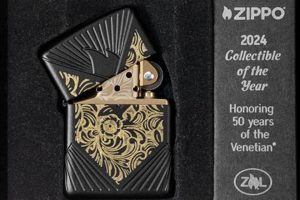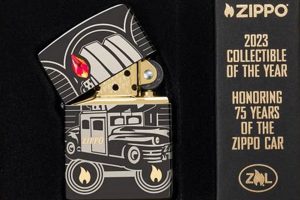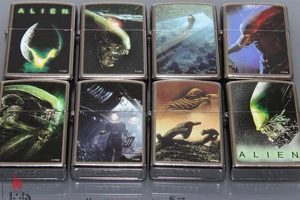Assemblages of lighters manufactured by Zippo Manufacturing Company during the World War II era represent tangible links to a pivotal period in history. These pocket-sized artifacts often bear unique engravings, military insignia, or personalizations reflecting the experiences of service members. A hypothetical example might include a lighter carried by a paratrooper during the Normandy landings, featuring his unit’s insignia and a scratched map of the drop zone.
Preserving these wartime lighters offers valuable insights into military culture, personal narratives, and manufacturing processes of the 1940s. They serve as primary source material for researchers and historians, offering glimpses into the daily lives of soldiers and the historical context of their service. The distinct designs and markings can reveal details about military units, campaigns, and individual experiences, contributing to a deeper understanding of the war’s impact. Their continued existence ensures that these stories are not lost to time.
This exploration will delve further into specific aspects of these historical artifacts, examining their variations, historical significance, and the burgeoning collector market surrounding them.
Tips for Collecting Wartime Zippo Lighters
Acquiring and preserving these historical artifacts requires careful consideration and informed decision-making. The following guidance offers practical advice for navigating the complexities of this specialized collecting field.
Tip 1: Authentication is Paramount: Verify a lighter’s wartime provenance through meticulous examination. Look for period-correct markings, materials, and construction methods. Consulting expert resources and reputable dealers is crucial for avoiding counterfeit items.
Tip 2: Condition Matters: Assess the lighter’s physical state. While “battle-worn” examples can possess historical value, significant damage can detract from collectibility. Consider the balance between historical significance and preservation.
Tip 3: Research Specific Markings: Decipher military unit insignias, personal engravings, and manufacturer stamps. Researching these details unlocks the stories behind each lighter, enhancing its historical value and providing deeper insights into its past.
Tip 4: Proper Storage is Essential: Protect lighters from environmental damage by storing them in a cool, dry environment away from direct sunlight. Avoid harsh cleaning agents that could damage the finish or markings.
Tip 5: Consider Provenance Documentation: Lighters accompanied by documented history, such as letters, photographs, or military records, hold significant added value. These supporting materials provide compelling evidence of the lighter’s journey through time.
Tip 6: Budget Wisely: Establish a budget and adhere to it. Rare and historically significant lighters can command substantial prices. Careful planning ensures a sustainable and rewarding collecting experience.
Tip 7: Engage with the Collector Community: Joining specialized forums, attending collector events, and networking with experienced enthusiasts provides valuable learning opportunities and access to reputable sources.
By adhering to these guidelines, collectors can build meaningful collections that preserve historical narratives and contribute to a deeper understanding of a pivotal era.
These considerations offer a starting point for embarking on a rewarding journey into the world of wartime lighter collecting. The subsequent sections will explore specific examples and further insights into this fascinating field.
1. Historical Significance
The historical significance of a World War II Zippo lighter collection extends beyond the objects themselves. These lighters offer a tangible connection to a pivotal period in global history, providing insights into military culture, individual experiences, and the broader context of the war. Examining these artifacts reveals a multifaceted narrative woven through personal stories, military history, and industrial production.
- Personal Narratives of Service Members
Engravings, personalized decorations, and even the wear and tear on a lighter can reveal glimpses into the lives of the individuals who carried them. A soldier’s initials, a unit insignia, or a hand-etched image of a loved one transforms a mass-produced object into a unique artifact, offering a poignant connection to personal experiences during wartime. These markings often provide clues to the soldier’s unit, deployment location, and personal beliefs, helping to reconstruct individual stories within the larger historical narrative. For instance, a lighter engraved with the emblem of the 101st Airborne Division and the name “John Smith” could lead researchers to explore Smith’s potential involvement in key operations like D-Day or Operation Market Garden.
- Reflection of Military Culture and Unit Identity
Military unit insignias and mottos etched onto lighters provide a snapshot of unit pride and esprit de corps. These markings illuminate the unique identity and traditions of specific military formations, offering insights into the social dynamics and cultural landscape within the armed forces. Trench art, often found on wartime lighters, showcases the creativity and resourcefulness of soldiers, transforming utilitarian objects into personalized expressions of their experiences and unit affiliations. A lighter adorned with the winged horse insignia of the 82nd Airborne Division, alongside a hand-carved paratrooper figure, embodies the unit’s distinct identity and its members’ pride in their specialized role.
- Window into Wartime Manufacturing and Material Culture
Zippo lighters from World War II reflect the wartime industrial landscape and material culture of the era. Changes in materials, construction methods, and even the availability of certain finishes offer a glimpse into the challenges and adaptations of wartime production. The shift from brass to steel casings due to material shortages, for example, provides tangible evidence of wartime resource management and its impact on manufacturing processes. These material changes, along with variations in finishes and markings, provide valuable data points for understanding the industrial history of the period.
- Commemoration and Remembrance
These preserved artifacts serve as tangible reminders of the sacrifices made during World War II. They act as focal points for remembrance and reflection, facilitating intergenerational dialogue about the war’s impact and the importance of preserving historical memory. The lighters offer a visceral connection to the past, enabling individuals to connect with the human stories behind the historical events. A lighter carried by a soldier during the Battle of the Bulge, passed down through generations, becomes a powerful symbol of family history and a tangible link to a pivotal moment in world history.
By considering these interconnected facets, collectors gain a deeper appreciation for the historical significance embedded within each lighter. A World War II Zippo collection becomes more than just an assemblage of objects; it transforms into a curated repository of personal narratives, military history, and wartime material culture, providing invaluable insights into a defining era.
2. Military Markings
Military markings on WWII Zippo lighters provide crucial context, transforming them from simple utilitarian objects into historical artifacts. These markings offer valuable insights into the wartime experiences of individual service members and the units to which they belonged. Deciphering these markings often reveals a wealth of information, connecting the lighter to specific military campaigns, theaters of operation, and historical events.
- Unit Insignia and Divisional Emblems
Unit insignias, often etched or painted onto lighters, signify a soldier’s affiliation with a specific military formation. These emblems represent divisional, regimental, or battalion-level affiliations, providing clues to the soldier’s role and the campaigns in which they participated. For example, the presence of the “Screaming Eagle” patch of the 101st Airborne Division could link a lighter to operations such as the Normandy landings or Operation Market Garden. These insignia offer a starting point for researching the unit’s history and the individual’s potential involvement in key historical events. The presence of specific unit markings can significantly enhance a lighter’s historical value and collectibility.
- Service Branch Identifiers
Markings indicating the branch of service such as “USN” for the United States Navy or “USAAF” for the United States Army Air Forces further contextualize the lighter’s history. These designations help collectors understand the environment in which the lighter was used, whether at sea, in the air, or on land. A lighter marked “USMC” (United States Marine Corps), for instance, might be linked to Pacific Theater campaigns such as the Battle of Iwo Jima or Guadalcanal. These identifiers, while seemingly simple, offer essential clues for researching the lighter’s historical context.
- Personal Identification and Rank Insignia
Initials, names, or service numbers engraved on lighters offer a glimpse into the individual soldier’s identity. These personalized markings transform the lighter into a unique artifact, connecting it directly to the person who carried it. Rank insignia, such as chevrons or bars, may also be present, indicating the soldier’s position within the military hierarchy. A lighter engraved with “Sgt. John Doe, 42nd Infantry Division” provides a starting point for genealogical research and potentially uncovering the individual’s wartime experiences. This personalization adds a significant layer of historical depth and emotional resonance to the artifact.
- Military Base or Location Codes
Some lighters bear markings that indicate specific military bases, training camps, or deployment locations. These codes or abbreviations, often cryptic, can provide valuable clues about the lighter’s journey during wartime. Deciphering these codes can reveal where a soldier trained, where they were stationed, or even the port of embarkation before deployment overseas. For example, a lighter marked “APO 464” indicates a connection to the European Theater of Operations during WWII. These location markers add a geographical dimension to the lighter’s history, enabling collectors to trace its potential path during the war.
By carefully examining and researching these military markings, collectors can uncover the rich history embedded within WWII Zippo lighters. These seemingly small details provide invaluable insights into individual experiences, unit histories, and the broader context of World War II, transforming these everyday objects into powerful historical artifacts. The presence, combination, and rarity of these markings significantly influence a lighter’s value within the collector market and its importance as a historical artifact.
3. Personal Engravings
Personal engravings on WWII Zippo lighters transform these utilitarian objects into deeply personal artifacts, offering poignant glimpses into the lives and experiences of the individuals who carried them. These engravings provide a unique form of historical documentation, capturing personal expressions of love, patriotism, humor, and remembrance amidst the backdrop of war. Understanding the significance of these engravings is essential for appreciating the human dimension within a WWII Zippo collection.
These engravings range from simple initials and dates of service to intricate artwork, poems, and personal mottos. A lighter engraved with “To my sweetheart, Betty” speaks volumes about the emotional connections that sustained soldiers during wartime. Another, etched with a cartoon character and the phrase “Kilroy was here,” reflects the humor and camaraderie that helped individuals cope with the stresses of combat. A lighter bearing a meticulously engraved image of a religious icon reveals the importance of faith and spiritual solace during times of uncertainty. These personalized expressions humanize the historical narrative, connecting collectors to the individual experiences of those who served. A lighter inscribed with the coordinates of a significant battle, for example, offers a tangible link to a specific place and time, enriching our understanding of the war’s geographical and historical context. The presence of personal engravings significantly enhances a lighter’s historical value and provides invaluable insights into the emotional landscape of wartime.
The study of personal engravings on WWII Zippo lighters provides a unique window into the emotional and psychological landscape of wartime. These markings offer a tangible connection to the individuals who served, transforming mass-produced objects into personalized expressions of love, loss, hope, and resilience. Recognizing the significance of these engravings elevates a collection from a mere assemblage of objects to a curated repository of personal narratives and historical memory. Preserving these artifacts ensures that these individual stories, often untold in official historical accounts, are not lost to time. Challenges in interpreting these engravings can arise due to wear, damage, or the use of coded language or symbols. However, these challenges often add to the intrigue, prompting further research and deeper engagement with the historical context. Ultimately, personal engravings enrich our understanding of the human experience during wartime, providing a powerful and enduring connection to the past.
4. Manufacturing Variations
Variations in Zippo lighter production during World War II provide crucial insights for collectors and historians. These wartime adaptations, driven by material shortages and increased demand, resulted in distinct features that differentiate these lighters from their pre-war and post-war counterparts. Understanding these manufacturing variations is essential for authenticating wartime Zippos and appreciating their historical context within a collection.
- Case Construction and Materials
Wartime material shortages led to the substitution of brass with steel for lighter casings. This shift is a key identifier of WWII-era Zippos. Steel cases often exhibit a duller finish compared to the polished brass of pre-war models. Variations in steel quality and plating processes also contribute to subtle differences in appearance and durability among wartime examples. Collectors often examine the bottom stamp and hinge construction to identify specific wartime production periods and variations.
- Bottom Stamps and Date Codes
The bottom stamp on a Zippo lighter provides valuable information about its manufacturing date and location. During WWII, specific markings and date code formats evolved, reflecting changes in production processes and factory locations. Collectors utilize these markings to pinpoint a lighter’s production within the wartime timeframe and identify variations associated with specific production periods. These stamps serve as crucial evidence for authentication and contribute significantly to a lighter’s historical value within a collection.
- Finish and Plating
Wartime Zippo finishes often exhibit a less refined appearance compared to pre-war models. The use of substitute materials and streamlined production processes resulted in variations in plating quality and overall finish. Some wartime lighters feature a “black crackle” finish, developed for military use to reduce glare. These variations in finish are not defects but rather reflections of wartime production constraints and specific military requirements. Recognizing these nuances is essential for discerning authentic wartime examples.
- Internal Components and Mechanisms
Subtle variations in internal components, such as the flint wheel and striker mechanism, can distinguish wartime Zippos from other periods. Changes in material composition and manufacturing techniques resulted in slight differences in the functionality and durability of these internal parts. Collectors examine these internal mechanisms to verify a lighter’s authenticity and gain further insights into its production history. While less visually apparent than external features, these internal variations are crucial for accurate identification and historical contextualization.
By understanding these manufacturing variations, collectors can develop a more nuanced appreciation for the historical context of WWII Zippo lighters. These variations are not merely production anomalies but rather tangible evidence of wartime resourcefulness and adaptation. They provide valuable clues for authenticating lighters, dating them accurately, and understanding their place within the broader narrative of World War II history. This detailed analysis of manufacturing variations complements the study of military markings and personal engravings, offering a comprehensive understanding of the historical significance embedded within each lighter.
5. Condition and Preservation
The condition of a WWII Zippo lighter directly impacts its historical value and collectibility. Preservation efforts focus on maintaining a lighter’s current state, preventing further deterioration, and ensuring its long-term survival as a historical artifact. Balancing the preservation of a lighter’s “as-found” condition with necessary conservation measures presents a key challenge for collectors. Understanding the various factors affecting condition and employing appropriate preservation techniques is crucial for safeguarding these tangible links to the past.
- Assessing Existing Damage
Evaluating a lighter’s condition involves careful examination for signs of wear, damage, and previous repairs. Common issues include scratches, dents, corrosion, and missing parts. The extent and type of damage influence a lighter’s value and inform appropriate preservation strategies. A lighter exhibiting significant battle damage, for example, might be historically valuable despite its imperfections, while a lighter with extensive post-war repairs might hold less significance. Documenting existing damage through detailed photographs and written descriptions is crucial for monitoring its condition over time.
- Cleaning and Conservation Techniques
Cleaning a WWII Zippo requires careful consideration to avoid damaging the original finish or patina. Gentle cleaning methods using appropriate solvents and tools are essential. Conservation efforts might involve stabilizing corroded areas or repairing damaged parts, while striving to maintain as much of the original material as possible. Consulting with experienced conservators is recommended for addressing significant damage or complex preservation issues. Overly aggressive cleaning or improper repairs can diminish a lighter’s historical value.
- Proper Storage Environments
Protecting a WWII Zippo from further deterioration requires appropriate storage conditions. Lighters should be stored in a cool, dry environment away from direct sunlight and extreme temperature fluctuations. Specialized storage cases or archival-quality materials can further protect lighters from environmental damage and minimize the risk of scratches or dents. Proper storage is essential for long-term preservation and maintaining a lighter’s historical integrity.
- Documentation and Archival Practices
Maintaining detailed records of each lighter, including provenance information, condition assessments, and preservation measures, is essential for responsible collecting. Photographs, written descriptions, and any accompanying historical documentation should be organized and preserved alongside the lighter itself. These records enhance a collection’s historical value and provide valuable context for future research. Employing archival practices ensures that the stories and historical significance associated with each lighter are preserved alongside the physical artifact.
Condition and preservation are integral aspects of WWII Zippo lighter collecting. By understanding the factors that contribute to a lighter’s condition and employing appropriate preservation techniques, collectors safeguard these historical artifacts for future generations. Careful assessment, informed conservation decisions, and proper storage practices ensure that these tangible links to a pivotal era remain accessible and continue to offer insights into the past. The condition of a lighter, considered alongside its historical context, military markings, and personal engravings, provides a comprehensive understanding of its significance within a WWII Zippo collection.
6. Authenticity Verification
Authenticity verification is paramount within WWII Zippo lighter collecting. Establishing a lighter’s genuine wartime provenance requires meticulous scrutiny and a comprehensive understanding of period-specific manufacturing techniques, markings, and materials. The process safeguards collectors from acquiring counterfeit or misrepresented items and ensures the historical integrity of collections. Verification relies on a multi-faceted approach, combining physical examination, historical research, and expert consultation.
- Bottom Stamp Analysis
The bottom stamp serves as a primary indicator of a Zippo’s production date and authenticity. Wartime stamps exhibit specific characteristics, including font styles, spacing, and depth of impression. Variations in these features correspond to different production periods within WWII. Collectors consult detailed reference guides and online resources to compare a lighter’s bottom stamp against documented wartime examples. Discrepancies in the stamp’s features can indicate a reproduction or a lighter from a different era. A correctly formatted and period-appropriate bottom stamp is a crucial first step in authentication.
- Case Construction and Materials
Wartime material shortages necessitated the use of steel instead of brass for Zippo lighter casings. Examining the case material and construction methods aids in authentication. Steel cases often exhibit a different finish and weight compared to brass. Furthermore, wartime production techniques resulted in subtle variations in hinge construction and seam placement. These physical attributes, when compared against known wartime examples, help differentiate genuine artifacts from later reproductions or lighters from different periods. Careful scrutiny of the case’s physical characteristics is essential for verifying authenticity.
- Patina and Wear Patterns
Genuine WWII Zippo lighters often exhibit unique patina and wear patterns consistent with their age and purported use. The natural aging of the metal, combined with potential exposure to the elements during wartime, creates distinct surface characteristics. Examining the lighter for appropriate signs of wear, such as scratches, discoloration, or tarnish, helps assess its authenticity. However, artificially aged reproductions exist, requiring careful discernment and comparison with documented wartime examples. While patina can be indicative of age, it should be considered alongside other authentication factors.
- Expert Consultation and Provenance Research
Consulting with recognized Zippo experts and conducting thorough provenance research significantly strengthens authentication efforts. Experts possess in-depth knowledge of wartime production variations, markings, and materials, enabling them to identify genuine artifacts and detect counterfeits. Provenance research, which involves tracing a lighter’s ownership history through documentation such as letters, photographs, or military records, provides compelling evidence of its wartime origins. A well-documented provenance significantly enhances a lighter’s historical value and strengthens its authenticity. Combining expert consultation with provenance research provides the most robust approach to verification.
Authenticity verification is an essential process within WWII Zippo lighter collecting. By carefully examining a lighter’s physical characteristics, researching its provenance, and consulting expert resources, collectors can confidently assess its genuineness. This meticulous approach ensures the integrity of collections, safeguards against acquiring counterfeit items, and preserves the historical significance of these tangible links to a pivotal era. Authenticity verification, combined with a thorough understanding of historical context, military markings, and personal engravings, allows collectors to fully appreciate the historical depth and value embedded within each WWII Zippo lighter.
7. Collector Market Value
Collector market value within the realm of WWII Zippo lighters represents a complex interplay of historical significance, rarity, condition, and provenance. Understanding these factors is crucial for collectors seeking to assess the monetary worth of their items or navigate the marketplace. Value fluctuations reflect not only the inherent qualities of individual lighters but also broader trends within the collecting community and the historical memorabilia market. This exploration delves into the key facets that influence collector market value, providing insights into the dynamics of this specialized collecting niche.
- Rarity and Historical Significance
Rarity significantly influences a WWII Zippo’s value. Lighters associated with specific battles, military units, or historical figures command higher prices due to their limited numbers and unique historical context. For example, a lighter documented as belonging to a prominent general or carried during a pivotal battle can achieve significant market value. Similarly, lighters featuring rare military insignia or unique wartime modifications are highly sought after by collectors, driving their prices upward. The intersection of historical significance and rarity creates a premium within the collector market.
- Condition and Preservation
A lighter’s condition plays a crucial role in determining its value. Lighters in pristine or near-mint condition, exhibiting minimal wear and tear, generally command higher prices than those with significant damage or corrosion. However, “battle-worn” examples, bearing evidence of their wartime service, can also hold significant value, particularly if the damage can be directly attributed to specific historical events. The balance between preservation and historical wear contributes to a lighter’s overall appeal and market value.
- Provenance and Documentation
Documented provenance significantly enhances a WWII Zippo’s value. Lighters accompanied by supporting documentation, such as period photographs, letters, or military records, offer verifiable evidence of their history and ownership. This documented provenance strengthens a lighter’s authenticity and adds a layer of historical depth, making it more desirable to collectors. A lighter with a clear chain of custody tracing back to a specific WWII service member, for instance, can achieve a significantly higher market value than a similar lighter lacking such documentation. Provenance provides a tangible link to the past, increasing both historical significance and monetary value.
- Market Trends and Collector Demand
Collector demand and broader market trends also influence WWII Zippo lighter values. Fluctuations in market interest, driven by factors such as historical anniversaries, media portrayals, or renewed interest in specific military campaigns, can impact prices. Furthermore, the availability of specific lighter models or variations within the collector market affects their desirability and value. Limited availability coupled with high collector demand can drive prices significantly upward. Monitoring market trends and understanding collector preferences are crucial for navigating the dynamic landscape of WWII Zippo lighter valuations.
Collector market value within WWII Zippo collections reflects a confluence of historical significance, rarity, condition, and market dynamics. By understanding these interconnected factors, collectors can make informed decisions regarding acquisitions, sales, and appraisals. Recognizing the interplay of these elements provides a comprehensive understanding of the forces shaping value within this specialized collecting field, allowing collectors to appreciate not only the historical significance but also the market dynamics surrounding these tangible links to the past.
Frequently Asked Questions
This section addresses common inquiries regarding World War II Zippo lighter collections, providing concise and informative responses to facilitate a deeper understanding of this specialized collecting field.
Question 1: How can one differentiate between a genuine WWII Zippo and a reproduction?
Several key features distinguish authentic wartime lighters. Careful examination of the bottom stamp, case material (steel versus brass), and internal components is crucial. Consulting expert resources and comparing the lighter to documented wartime examples are recommended.
Question 2: What factors contribute most significantly to a WWII Zippo’s value?
Rarity, historical significance, condition, and documented provenance are primary determinants of value. Lighters associated with specific battles, units, or individuals, especially those in excellent condition with verifiable history, command higher prices.
Question 3: Are “battle-worn” lighters less valuable than those in pristine condition?
Not necessarily. While pristine lighters generally command higher prices, “battle-worn” examples exhibiting genuine wartime wear can hold significant historical value, particularly if the damage is documented or related to specific events.
Question 4: Where are reputable sources for acquiring authentic WWII Zippo lighters?
Reputable dealers specializing in militaria, established auction houses, and reputable online marketplaces are potential sources. Thorough research, careful authentication, and scrutiny of seller reputations are crucial.
Question 5: How should WWII Zippo lighters be stored to ensure their long-term preservation?
Storage in a cool, dry environment away from direct sunlight and extreme temperatures is essential. Specialized storage cases or archival-quality materials provide additional protection against environmental damage.
Question 6: What resources are available for researching the history and markings found on WWII Zippo lighters?
Specialized books, online forums dedicated to Zippo collecting, and museum archives offer valuable resources for researching military markings, unit histories, and manufacturing variations. Consulting with experienced collectors can also provide valuable insights.
This FAQ section offers a starting point for navigating the complexities of WWII Zippo lighter collecting. Further research and engagement with the collector community are encouraged for continued learning and informed collecting practices.
Exploring specific case studies of notable WWII Zippo lighters provides further insight into the historical narratives embedded within these artifacts. The following section delves into specific examples, illustrating the principles discussed throughout this exploration.
WWII Zippo Lighter Collections
Collections of WWII Zippo lighters offer a tangible connection to a pivotal period in global history. From the analysis of military markings and personal engravings to the nuances of manufacturing variations and the complexities of authentication, these artifacts embody individual narratives, military history, and wartime material culture. Preservation efforts and responsible collecting practices ensure the continued accessibility of these historical objects, enabling ongoing research and facilitating intergenerational dialogue about the war’s enduring legacy.
These seemingly small objects hold within their metal casings profound stories of service, sacrifice, and resilience. Continued research, meticulous preservation, and engagement with these collections ensure that the individual experiences and historical narratives embodied within WWII Zippo lighters remain accessible, fostering a deeper understanding of a transformative era and its lasting impact.







